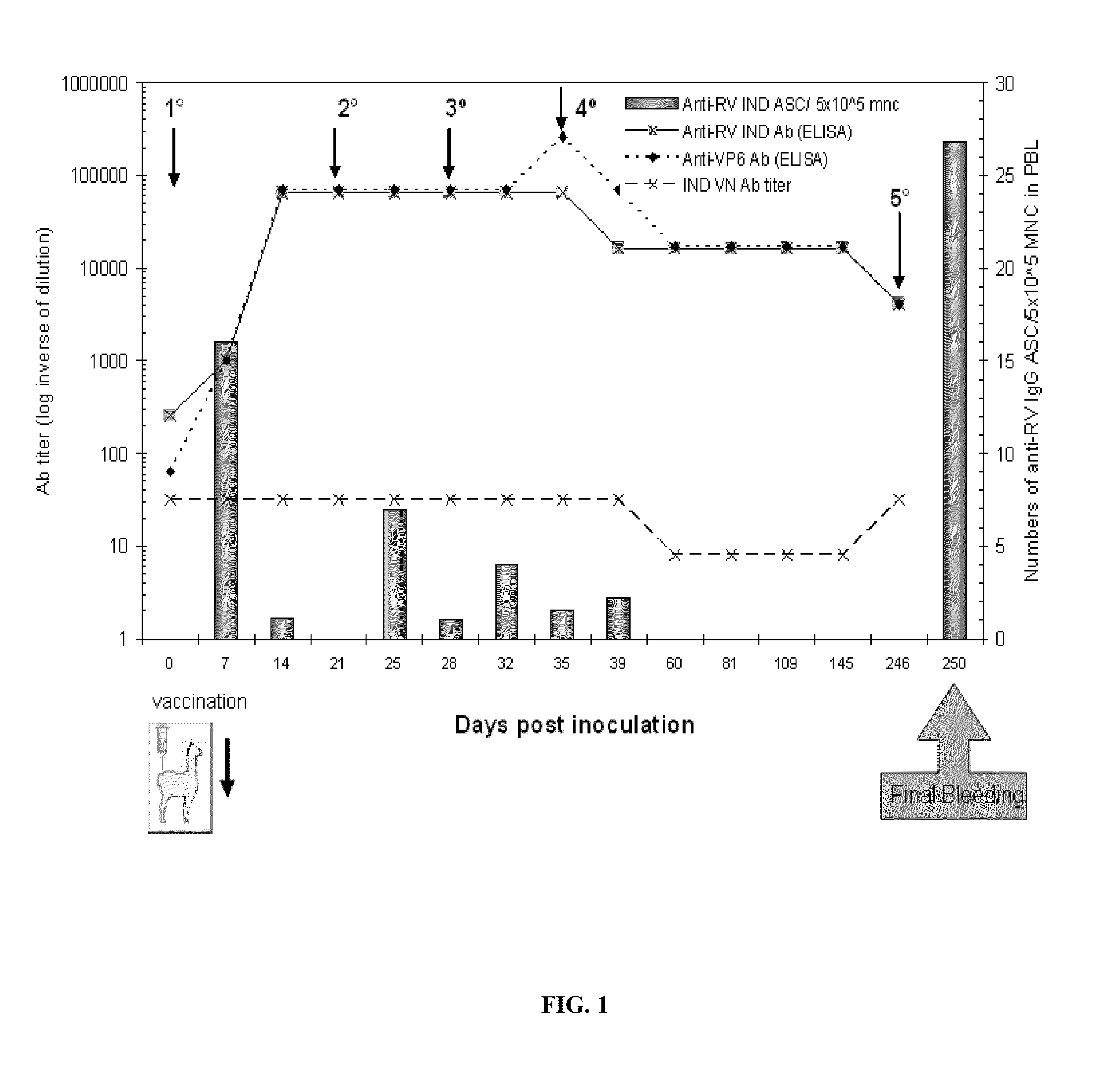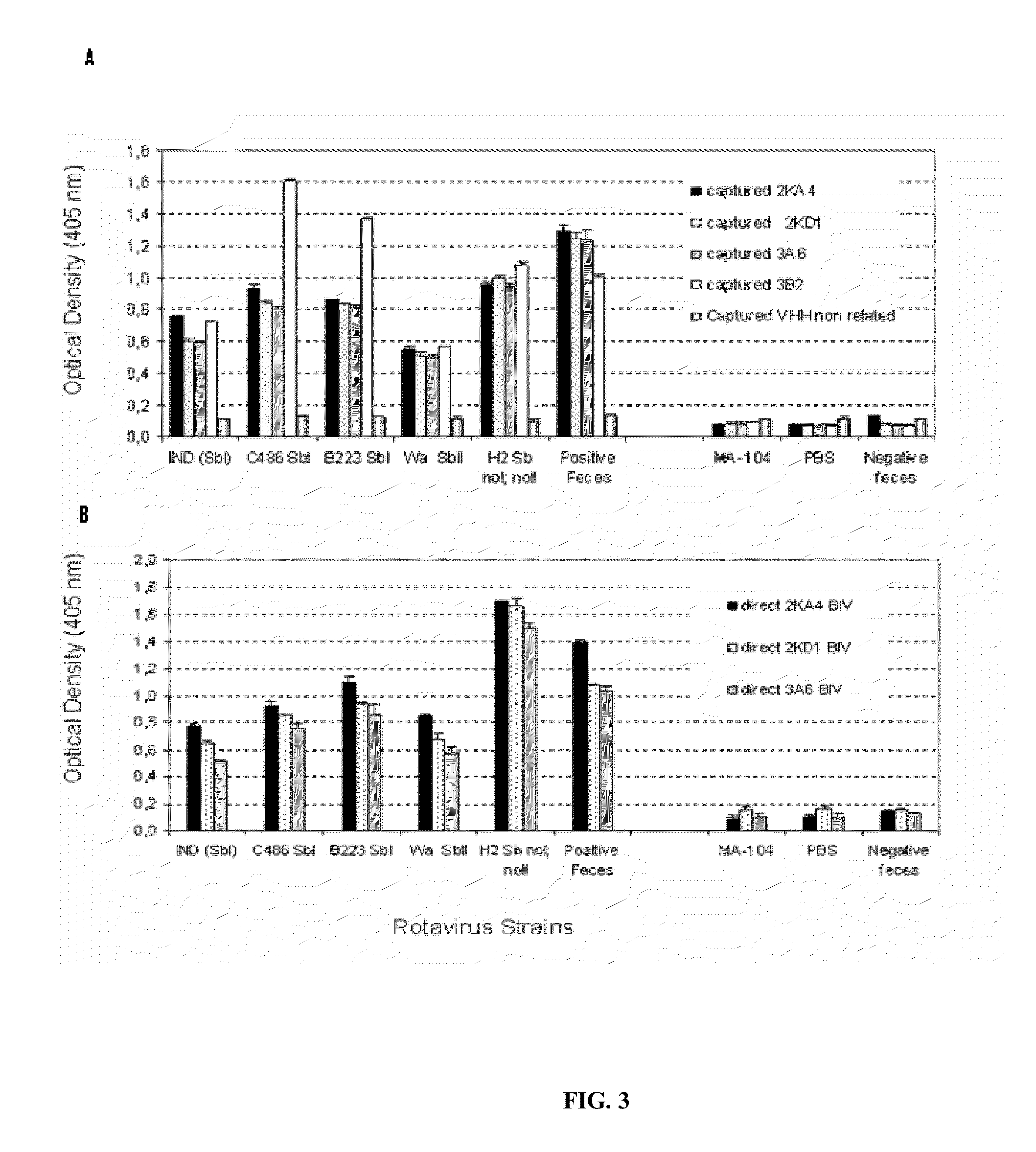Monomeric vhh domain derived from Anti-vp6 camelid antibodies, dimeric domain, immunisation method, rotavirus detection method, composition, prevention and treatment methods for rotavirus infections
a technology of antibody and vhh domain, which is applied in the field of monomeric vhh domain derived from anti-vp6 camelid antibodies, immunisation methods, compositions, etc., can solve the problems of high cost of prevention or treatment, inability to prevent rv infection, and low reproducibility,
- Summary
- Abstract
- Description
- Claims
- Application Information
AI Technical Summary
Benefits of technology
Problems solved by technology
Method used
Image
Examples
example 1
Obtainment and Purification of the Monomeric and Dimeric VHH of the Invention
Obtainment of the VHH Library of the Invention:
[0094]The reference bovine IND RV strain was used (SbI; P[5]G6) as an antigen in the biopanning process to select the VHH. In order to have an RV panel that represents different subgroup reactivities with different combinations of G and P types from different animal species and from humans, the reference RV strains listed in Table 4 were included in the different assays performed to produce the VHH. The viruses were propagated in monkey kidney cells (MA-104). Also included was a faecal sample from a colostrum-deprived neonatal calf infected with the IND strain at the time of pre-inoculation and at the peak of virus spreading.
TABLE 5Reference rotavirus strains used in the different procedures performedduring the production and characterisation of the VHH of the inventionRVSpeciesStrainof originSubgroupG-P typeProcedureC486BovineIP[1]G6Recombinant VP6 antigenused...
example 2
Characterisation of the VHH of the Invention
[0101]VP6 concentrates expressed in a baculovirus system and BRV IND concentrates were re-suspended in a Laemmli sample buffer, boiled for 10 minutes. They were then run through a 12% SDS-PAGE column and transferred to an Immobilon P membrane (Millipore, Berdford, Mass.). The membrane was blocked for 45 min with PBS / Tween (0.05%), containing 10% skim milk, and each of the VHH (4 μg / ml) were incubated for 2 h at ambient temperature. The membrane was then washed with PBS / Tween (0.05%) and incubated overnight at 4° C. with the anti-pentahistidine antibody ( 1 / 500 dilution in PBS / Tween (0.05%) BSA (3%). Finally, they were incubated with HRP-conjugated goat anti-mouse IgG ( 1 / 5,000 dilution) (Amersham, Pharmacia, Biotech) for 40 min at ambient temperature. The assays were developed with ECL (Amersham Biosciences).
Sequencing of the VHH of the Invention:
[0102]In order to sequence the VHH, the “M13 forward” and “M13 reverse” oligonucl...
example 3
RV Immunodetection Assays Using the VHH of the Invention
Enzyme Immunoassay (ELISA) and Western Blot:
[0103]The ELISA experiments were performed in Maxisorp 96-well plates (Nunc), by direct sensitisation with RV or by capture of RV or of recombinant VP6 with a polyclonal antibody produced in a gnotobiotic pig. As antigens for the negative control, pseudo-infected MA-104 cells and a non-related protein expressed in baculoviruses (protein E2 of the bovine diarrhoea virus) were used. PBS was used as a blank, and non-immunised guinea pig serum was used as a negative capture.
[0104]The presence of anti-RV antibodies in the llama serum was analysed as described in Parreno, V. C. et. al., Vet Immunol Immunopathol 100:7-24, 2004, and that of anti-VP6 antibodies was analysed with a protocol adapted from Fernandez et al. (Fernandez, F. M. et al., Vaccine 16:507-16, 1998). The llama IgG were detected using a peroxidase-labelled goat anti-llama IgG (H+L) (Bethyl, lab inc, Montgomery, Calif., USA),...
PUM
 Login to View More
Login to View More Abstract
Description
Claims
Application Information
 Login to View More
Login to View More - R&D
- Intellectual Property
- Life Sciences
- Materials
- Tech Scout
- Unparalleled Data Quality
- Higher Quality Content
- 60% Fewer Hallucinations
Browse by: Latest US Patents, China's latest patents, Technical Efficacy Thesaurus, Application Domain, Technology Topic, Popular Technical Reports.
© 2025 PatSnap. All rights reserved.Legal|Privacy policy|Modern Slavery Act Transparency Statement|Sitemap|About US| Contact US: help@patsnap.com



